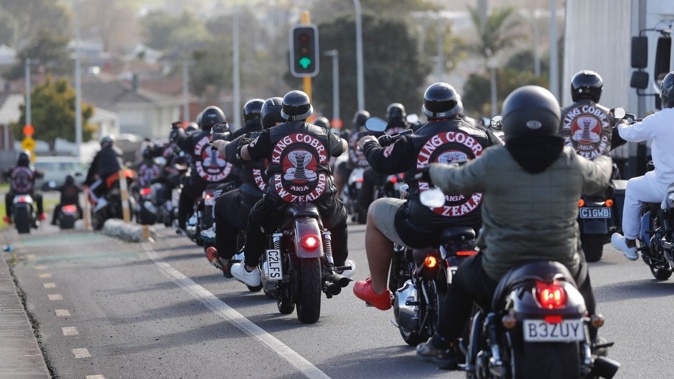
ANALYSIS
The Coalition Government has a mandate to crack down on gangs, and is wasting no time with new initiatives in its 100-day plan. But such laws can have unintended consequences including being used on those with no gang links, or to target the disadvantaged including the indigenous and the homeless. Derek Cheng looks at where this has happened, how it might be avoided, and whether the Government is taking note.
All three governing parties campaigned on getting tough on crime and tightening the screws on gangs.
Police Minister Mark Mitchell has already set out his clear expectations for Police Commissioner Andrew Coster to “ensure gangs will not take over towns, public roads or spaces”, and for police to “use the full force of the law and the tools and resources it has available to significantly disrupt gang and organised crime”.
Those tools and resources will be broadened with new legislation the Government is introducing in its first 100 days to ban gang patches, stop gang members from gathering in public, and stop known gang offenders from communicating with one another.
There will also be greater police powers to search gang members for firearms, and make gang membership an aggravating factor at sentencing, though this is already the case under the Sentencing Act.
The expectation is that putting more pressure on gangs will contribute to less crime and intimidation, and improve public safety. Whether this will happen is uncertain.
What has happened, here and overseas, is that police have used anti-gang powers on people with no gang links at all, who are then presumed to be a danger. This is what some academics call “hyper-criminalisation”.
And if you’re not a gang member and shouldn’t be presumed dangerous, then restricting where you can go and who you can communicate with becomes a violation of basic rights.
So how will the Government enable police to hit the gangs where it hurts, but limit the ability for the new powers to be misused?
Lessons from New Zealand history
Last year’s independent report Making Gang Laws in a Panic - by University of Canterbury sociologist Jarrod Gilbert, who once spent five years with gangs - found that previous anti-gang laws had minimal impact.
It found:
- Only two people had been charged under two new offences - habitually associating with a violent offender, and habitually associating with a drug offender - and one of them wasn’t a gang member.
- Allowing the removal of gang fortifications had been “scarcely employed” and, when used, “seldom” successful.
- A new criminal harassment offence resulted in an average of 71 people being charged annually, but only 9.5 per cent of them were linked to gangs.
- The only change that could be interpreted as a success was the charge of participation in an organised criminal group; 60 per cent of those charged were linked to gangs.
“The legislation that was specifically created to target gangs has more often been employed as general law and order tools,” Gilbert said in his report, and while some of those may be useful, “it is clear that they have not had any meaningful impact on the gang scene“.
His report, commissioned by the New Zealand Law Foundation, noted Australian research that gang crime only makes up a “very small percentage of criminal offending”, and that anti-gang laws in Australia have mirrored those in New Zealand in their greater use against those who are not gang members.
/cloudfront-ap-southeast-2.images.arcpublishing.com/nzme/DGDZ6PEYP5HD7DPGLQTHYLXQEY.jpg) Hundreds of gang members gather for William "Bird" Hines’ funeral in Foxton. Photo / Bevan Conley
Hundreds of gang members gather for William "Bird" Hines’ funeral in Foxton. Photo / Bevan Conley
Lessons from Australia
The development of anti-gang legislation across the Tasman shares many of the issues identified in Gilbert’s report: new legislation passed under urgency and driven by high-profile gang clashes, and new police powers that were then used mostly against non-gang people - and with questionable impact.
In 2013, a public brawl between bikies at Broadbeach led to a suite of OMCG (outlaw motorcycle gang) laws in Queensland. These included the controversial Vicious Lawless Association Disestablishment Act (VLAD), which set out mandatory sentences of at least 15 years’ jail for certain qualifying offences that a group of gang members had committed.
There was also a new non-association offence, so gang members couldn’t get together in groups of three or more, a “clubhouse” offence for entering a certain place or event, and a recruiting offence - all carrying minimum mandatory jail terms.
Of the 202 people charged under VLAD, only 10 per cent were OMCG members and 7 per cent were associates, while 82 per cent had no known gang links, a taskforce’s report in 2016 found.
Only two of the 202 people were sentenced as a “vicious lawless associate”, in both cases for drug trafficking. Of the 42 people charged with a non-association offence, none were successfully prosecuted.
The taskforce, chaired by former Supreme Court Judge Alan Wilson, found similar patterns in other parts of Australia: In South Australia, only 10 of the 84 people charged for knowingly taking part in a gang were actually gang members.
Some successes were also noted.
There were 155 public safety orders issued against individual OMCG members in relation to 12 to 15 events in South Australia. The orders can ban certain people from certain places, and all but one of the 155 people stayed clear of the event or place in question, minimising the potential for public acts of violence.
This type of order is not currently being considered in New Zealand, but a non-consorting order is among the Coalition Government’s suite of measures, and such orders have disrupted bikie meetings in New South Wales, according to a 2016 academic paper.
/cloudfront-ap-southeast-2.images.arcpublishing.com/nzme/XBO25QXE6PBPTGMBWHQAGB35KE.jpg) Some of the bikie gangs in Australia have been displaced to New Zealand after some members were deported here. Photo / Thinkstock
Some of the bikie gangs in Australia have been displaced to New Zealand after some members were deported here. Photo / Thinkstock
“Whether there has been any reduction in the criminal activity of bikie gangs is not yet established,” says the paper, titled The ‘Bikie Effect’ and Other Forms of Demonisation: The Origins and Effects of Hyper-Criminalisation.
“What is clear is that the consorting legislation is having a much wider effect than the demonised target at which the Government claimed it would be directed. The first man charged and convicted with consorting [under the new offence] had no motorcycle or criminal gang connections, and received an official warning from the police while grocery shopping with a housemate who had a criminal record.”
The Wilson report made a similar finding, saying the police had cast the non-consorting net wide, “mostly capturing associations between low-level criminals, rather than serious organised criminals”.
Police Minister Mark Mitchell has said the Coalition Government’s anti-gang legislation will have references to what’s happened in Western Australia, though the most recent laws there were passed in 2020 - after a public sniper-style assassination of a bikie boss - and these haven’t been so thoroughly reviewed.
A 2021 review of anti-gang laws in Australia noted the number of OMCG members had fallen in Queensland by 18 per cent from 2015 to 2019, in South Australia by 30 per cent over a three-year period, and in ACT by more than 50 per cent between 2018 and 2020.
Part of this is thought to be displacement, or gang members leaving one state for another where there are fewer such anti-gang laws, which just moves the crime to a different place.
And this wouldn’t happen in New Zealand because, unlike in Australia, you can’t just drive a few hours and be in a place where a different set of laws apply.
“Over time and as new states [in Australia] introduce legislation, there are fewer locations for offenders to displace to,” says Auckland University Professor Ian Lambie, who is the Office of the Prime Minister’s chief science advisor on justice.
“New Zealand’s smaller geographical area limits the extent to which offenders can relocate.”
The gang landscape in New Zealand is also different, he adds.
“While we have seen an increase in the number of outlaw motorcycle gangs in New Zealand over the past few years, some having arrived by way of 501 deportation [from Australia], we also have gangs that are inter-generational in nature and deeply embedded in their respective communities.
“The impacts of the proposed legislation will likely be felt differently amongst the different cohorts.”
Targeting the marginalised
A review by the NSW Ombudsman in 2016 found evidence that the non-consorting law was being used to target high-risk OMCGs; half of the non-consorting warnings and three-quarters of the charges came from a specific police squad targeting bikie gangs.
But the law was also being used in general policing, and the review found police had disproportionately applied them to the “disadvantaged and vulnerable” - including Aborigines, the homeless, and the young - and for minor offences.
Police were also guilty of an “exceptionally high” error rate when it came to children and young people.
“Almost 80 per cent of children and young people who had their associates warned about consorting with them were mistakenly identified as ‘convicted offenders’ by police,” the review said.
“This resulted in nearly 200 invalid warnings and represents a significant waste of policing resources, as well as an unknown impact on those directly affected.
“We also identified clusters of use by general duties police officers in relation to people experiencing homelessness. In one Sydney metropolitan area, we were advised by a community service provider that people were no longer attending their support services for fear of being further targeted for consorting.”
Submissions to the Law Enforcement and Conduct Commission said that 40 per cent of people subjected to the non-consorting laws in NSW over an 18-month period to June 2019 were Aboriginal, who account for 2.5 per cent of the population.
/cloudfront-ap-southeast-2.images.arcpublishing.com/nzme/Z42ZVBIVQRCALJL4RV5MA3B2EE.jpg) Police are unsurprisingly supportive of greater powers to tackle gangs, but police discretion is imperfect and the powers can be misused. Photo / Hayden Woodward
Police are unsurprisingly supportive of greater powers to tackle gangs, but police discretion is imperfect and the powers can be misused. Photo / Hayden Woodward
Unsurprisingly, there was plenty of police support for the new powers.
NSW Police said the non-consorting laws were “useful”, according to the Wilson report, which also quotes South Australia Police on public safety orders: “The orders have been very effective in preventing violent activity at public events. There has only been one arrest for breach of a public safety order and the accused received a six-month suspended sentence of imprisonment.”
The report recommended replacing the 2013 laws in Queensland with something akin to post-conviction control orders in the UK, which can only be applied to someone convicted of a serious crime.
This would be a return to the “tried and proven” focus on individuals and the crimes they’ve committed, the report said, relegating who they did the crime with and in what way to a “circumstance of aggravation”.
“Despite many serious attempts and a great deal of legislative verbiage, [criminalising participation in a group rather individual offenders] cannot be described as successful anywhere,” the report said.
“Where it has not proved disproportionately expensive and time-consuming, it has inevitably involved some infringement upon rule of law principles and approached (or surpassed) the margins of constitutional validity.”
This aligns with the conclusions of the NSW Ombudsman review in 2016 of control orders that could be applied to all members of a gang.
“Despite high expectations, in practice no police force in Australia has been able to successfully utilise the legislation. The NSW experience, mirrored in other jurisdictions, has been resource-intensive and operationally challenging.”
Only one application was filed in court, the review said, but it was successfully challenged in a High Court which found the law was unconstitutional.
The tightrope the Government wants to walk
Justice Minister Paul Goldsmith is well aware of the need to make new police powers broad enough to be useful, but narrow enough so they’re not misused.
He confirmed that a non-consorting order - or consorting prohibition order - would be part of the new measures. It would be illegal for the subject of an order to associate with specified people, most likely other gang members who are also the subject of such orders, for up to three years “so they’re not able to cook up new crimes”.
Noting some of the findings from the Australian research, he added: “They have to be a known gang offender, not a random stranger.”
Nor would an order be applicable to anyone with a clean record, even if they were a listed gang member. They would need to be convicted of a serious crime - it wouldn’t be retrospective - though the actual seriousness threshold is still being worked through.
And he said the need for court approval would add an extra layer of assurance.
“We had originally talked about them being made by the Commissioner of Police. We are now considering them being a court order, which would see a court go through the detail and give greater confidence to the system.”
/cloudfront-ap-southeast-2.images.arcpublishing.com/nzme/CJEEGVVLCQPTJFMCJWMFTBTQUU.jpg) Justice Minister Paul Goldsmith says the anti-consorting order won't be applicable to "random strangers" or people with no criminal record. Photo / Mark Mitchell
Justice Minister Paul Goldsmith says the anti-consorting order won't be applicable to "random strangers" or people with no criminal record. Photo / Mark Mitchell
A similar layer of assurance exists for a terrorist control order, which can restrict a terrorist’s movements and who they can contact. These orders are made by the High Court following an application from the Police Commissioner.
Goldsmith also noted different degrees of police power to clear a public space. If it can be applied before a potentially intimidating gang gathering is expected to happen, it could have a much greater impact on gang visibility than if it were reactive.
But that would also be much more open to misuse, so Goldsmith said a pre-emptive power is not being considered.
“The primary focus is a large gathering in a public place, intimidating the public. Police can say you’ve got to clear the area immediately and if you don’t, there will be consequences.”
Again, the detail of what would qualify for clearing the area is still being worked through. How many in the group? How intimidating, and how can that be measured? And what about a gang gathering near a school or kindergarten?
“The threshold is what we’re working through in terms of the actual wording in the legislation - ‘clear and justifiable’.”
Goldsmith said the anti-gang legislation will be introduced towards the end of the 100-day deadline because “it’s reasonably complex and we’ve got to get it right”.
The Government isn’t currently looking at something like the public safety orders in Australia, which prevent gang members from being in a specific place or event such as a private headquarters/clubhouse. The subject of a non-consorting order, however, couldn’t legally enter a clubhouse if the people they’re not allowed to contact were there.
Nor is there a plan to restrict gang members from working in certain industries. This would see them prevented from being issued licences, permits or contracts, or denied real estate or other assets - though similar outcomes may also be possible under the right non-consorting order.
“Such measures can be critical to cutting off offenders from the funding streams, physical and technical infrastructure and mechanisms for concealing illicit revenue that facilitate organised crime,” said a 2022 review of the use of this approach in Queensland.
The review found a suggestion of “a gradual reduction in organised crime-related harm by OMCG members (3 per cent to 4 per cent per month)”, though displacement of organised criminal networks to other states wasn’t considered.
Professor Ian Lambie told the Herald it was difficult to say the occupational restrictions were the cause of the decrease in gang-related harm.
/cloudfront-ap-southeast-2.images.arcpublishing.com/nzme/EGBU3PQPMZA6ZDALUG7U5EB6J4.jpg) Police Minister Mark Mitchell expects Commissioner of Police Andrew Coster to “use the full force of the law and the tools and resources it has available to significantly disrupt gang and organised crime". Photo / Alex Burton
Police Minister Mark Mitchell expects Commissioner of Police Andrew Coster to “use the full force of the law and the tools and resources it has available to significantly disrupt gang and organised crime". Photo / Alex Burton
Gangs won’t change without social change
Lambie is one of four authors of an extensive report on New Zealand gangs by the office of the Prime Minister’s Chief Science Adviser, along with chief science advisers Dame Juliet Gerrard, Tracey McIntosh (social development) and senior analyst Emma Brown.
“There are no quick-fixes,” the report says.
“Reducing gang harm will require addressing underlying societal issues which have been well-documented but unsolved: inequity, inter-generational trauma, housing, family violence, etc, all of which serve to narrow the choices of those in our society who experience complex and inter‐connected stressors.”
While suppression and enforcement serve a purpose, the report says a “‘zero‐tolerance’ style of policing builds distrust in the communities that police are tasked to serve”. “It creates alienation and dislocation from communities and risks fuelling gang membership and increasing gang dislocation and isolation.”
On specific policies, it said banning gang patches in Australia had led to a decrease in public violence and visibility, though there was a “high likelihood that a public ban simply pushed illegal activity underground”.
“A specific focus on gang membership and gang disengagement will be insignificant if the social conditions in which gangs exist and operate are not addressed.
“Protective factors that reduce the chance of a young person being involved in a gang include strong ties to family, school, and community. Investing in these young people to enable them to enjoy these protective factors offers the most hope of diminishing gang harm in the long-term.”
Goldsmith agreed that there needed to be social change, but that didn’t mean the Government shouldn’t enable police to come down hard on gangs.
“I just don’t think it’s a binary thing. Social change, education, the first 1000 days of baby’s life, social investment work - I absolutely agree with all of that.
“But you’ve also got to deal with the problem right here, right now, and the reality of towns being taken over by gangs and the intimidation they’ve brought.”
It’s also what people demand - and voted for.
“Having spent the year knocking on doors up and down the country alongside all my colleagues, very consistently the number two issue - behind cost-of-living - was law and order,” he said.
“That’s what we’re responding to.”
Derek Cheng is a senior journalist who started at the Herald in 2004. He has worked several stints in the Press Gallery and is a former deputy political editor
Take your Radio, Podcasts and Music with you









